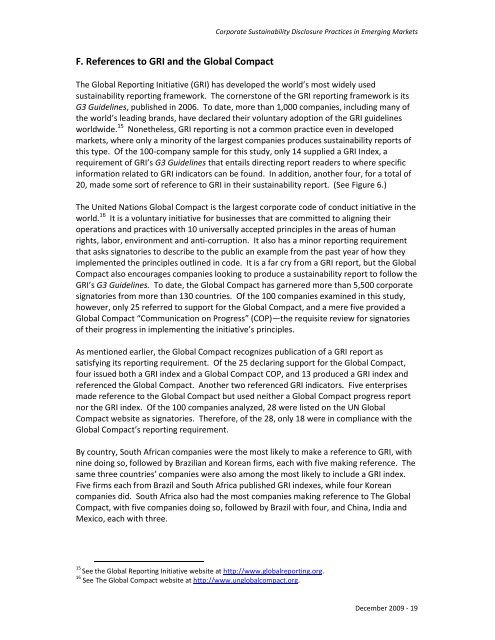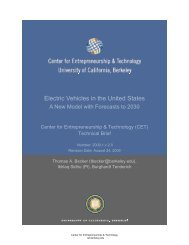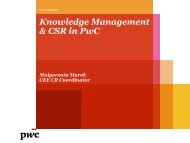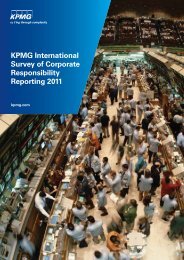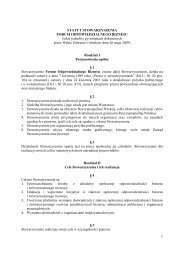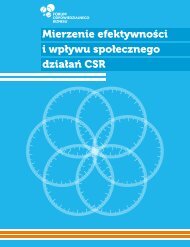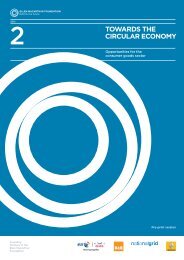Corporate Sustainability Disclosure in Emerging Markets
Corporate Sustainability Disclosure in Emerging Markets
Corporate Sustainability Disclosure in Emerging Markets
You also want an ePaper? Increase the reach of your titles
YUMPU automatically turns print PDFs into web optimized ePapers that Google loves.
<strong>Corporate</strong> <strong>Susta<strong>in</strong>ability</strong> <strong>Disclosure</strong> Practices <strong>in</strong> Emerg<strong>in</strong>g <strong>Markets</strong>F. References to GRI and the Global CompactThe Global Report<strong>in</strong>g Initiative (GRI) has developed the world’s most widely usedsusta<strong>in</strong>ability report<strong>in</strong>g framework. The cornerstone of the GRI report<strong>in</strong>g framework is itsG3 Guidel<strong>in</strong>es, published <strong>in</strong> 2006. To date, more than 1,000 companies, <strong>in</strong>clud<strong>in</strong>g many ofthe world’s lead<strong>in</strong>g brands, have declared their voluntary adoption of the GRI guidel<strong>in</strong>esworldwide. 15 Nonetheless, GRI report<strong>in</strong>g is not a common practice even <strong>in</strong> developedmarkets, where only a m<strong>in</strong>ority of the largest companies produces susta<strong>in</strong>ability reports ofthis type. Of the 100-company sample for this study, only 14 supplied a GRI Index, arequirement of GRI’s G3 Guidel<strong>in</strong>es that entails direct<strong>in</strong>g report readers to where specific<strong>in</strong>formation related to GRI <strong>in</strong>dicators can be found. In addition, another four, for a total of20, made some sort of reference to GRI <strong>in</strong> their susta<strong>in</strong>ability report. (See Figure 6.)The United Nations Global Compact is the largest corporate code of conduct <strong>in</strong>itiative <strong>in</strong> theworld. 16 It is a voluntary <strong>in</strong>itiative for bus<strong>in</strong>esses that are committed to align<strong>in</strong>g theiroperations and practices with 10 universally accepted pr<strong>in</strong>ciples <strong>in</strong> the areas of humanrights, labor, environment and anti-corruption. It also has a m<strong>in</strong>or report<strong>in</strong>g requirementthat asks signatories to describe to the public an example from the past year of how theyimplemented the pr<strong>in</strong>ciples outl<strong>in</strong>ed <strong>in</strong> code. It is a far cry from a GRI report, but the GlobalCompact also encourages companies look<strong>in</strong>g to produce a susta<strong>in</strong>ability report to follow theGRI’s G3 Guidel<strong>in</strong>es. To date, the Global Compact has garnered more than 5,500 corporatesignatories from more than 130 countries. Of the 100 companies exam<strong>in</strong>ed <strong>in</strong> this study,however, only 25 referred to support for the Global Compact, and a mere five provided aGlobal Compact “Communication on Progress” (COP)—the requisite review for signatoriesof their progress <strong>in</strong> implement<strong>in</strong>g the <strong>in</strong>itiative’s pr<strong>in</strong>ciples.As mentioned earlier, the Global Compact recognizes publication of a GRI report assatisfy<strong>in</strong>g its report<strong>in</strong>g requirement. Of the 25 declar<strong>in</strong>g support for the Global Compact,four issued both a GRI <strong>in</strong>dex and a Global Compact COP, and 13 produced a GRI <strong>in</strong>dex andreferenced the Global Compact. Another two referenced GRI <strong>in</strong>dicators. Five enterprisesmade reference to the Global Compact but used neither a Global Compact progress reportnor the GRI <strong>in</strong>dex. Of the 100 companies analyzed, 28 were listed on the UN GlobalCompact website as signatories. Therefore, of the 28, only 18 were <strong>in</strong> compliance with theGlobal Compact’s report<strong>in</strong>g requirement.By country, South African companies were the most likely to make a reference to GRI, withn<strong>in</strong>e do<strong>in</strong>g so, followed by Brazilian and Korean firms, each with five mak<strong>in</strong>g reference. Thesame three countries’ companies were also among the most likely to <strong>in</strong>clude a GRI <strong>in</strong>dex.Five firms each from Brazil and South Africa published GRI <strong>in</strong>dexes, while four Koreancompanies did. South Africa also had the most companies mak<strong>in</strong>g reference to The GlobalCompact, with five companies do<strong>in</strong>g so, followed by Brazil with four, and Ch<strong>in</strong>a, India andMexico, each with three.15See the Global Report<strong>in</strong>g Initiative website at http://www.globalreport<strong>in</strong>g.org.16 See The Global Compact website at http://www.unglobalcompact.org.December 2009 - 19


